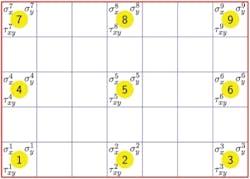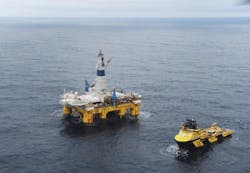Short-offset processed 3D seismic data can help map morphology and geohazards
Mazin Farouki
PGS
with contributions from
Dr. Nikolay Nenov
Geohazard Consultant
Simon Irwin
PGS
Francesco Paone
Eni
In deepwater, modern 3D seismic surveys intended primarily for exploration and development objectives are proving valuable for investigation of seabed morphology and analysis of shallow sub-seabed geohazards.
Petroleum Geo-Services (PGS) highlights one case study for operator Eni in Indonesia. The Eni Muara Bakau B.V. Production Sharing Contract (PSC) block is on the East Kalimantan shelf edge and the west slope of the Makassar straits, Indonesia. Water depths vary from 70 m (230 ft) on the shelf to more than 1,000 m (3,281 ft) at the east edge of the survey. The steep shelf edge leads into a generally eroded and canyonized slope. Seafloor stability is an issue as evidenced by seabed slumping. Debris flows originating at the shelf edge also may pose a risk. In addition, shallow gas accumulations are present.
Eni Muara Bakau contracted PGS to undertake a study to better understand the regional seabed morphology with respect to potential geohazards to field development. Short offset data from an existing conventional 3D seismic survey was reprocessed through customized processing flows to yield high spatial and vertical resolution data suitable for accurate seabed mapping and near surface geohazard studies.
Two independent reprocessing sequences were applied. The first was designed to accurately image the seabed, yielding high resolution data at a spatial sampling of 6.25 m x 12.5 m (20.6 ft x 41 ft). The second reprocessing flow was focused on the near surface section, approximately 1.5 seconds TWT beneath the seafloor, and included generating data attributes such as amplitude, coherency, and angle-versus-offset (AVO) diagnostics to identify shallow gas.
Most modern exploration 3D seismic surveys are likely to be suitable as the basis for shallow geohazard analyses. Essential criteria are the frequency bandwidth recorded and the near offsets relative to the water depth. In shallow water, multiples and refractions can be a problem. The 3D seismic acquisition geometry is optimized for much deeper targets and not as much of an issue there. The general rule of thumb is that the 3D seismic data should be recorded at 2 ms or smaller sample interval and the near offset acquired should be less than half the water depth.
Another issue with utilizing 3D seismic data for shallow geohazards may be the position of the notch in the frequency spectrum, which is optimized for deeper targets. This was eliminated by the advent of broadband marine seismic acquisition, introduced in recent years by PGS. By eliminating the receiver and source ghost recordings in towed marine seismic, GeoStreamer technology delivers broadband seismic data free of ghost notches, which improves resolution of events and allows the reliable interpretation of shallow geohazards.
Traditional site surveys in shallow water typically are conducted using a grid of 2D high resolution seismic lines over a limited area, usually 1 sq km (0.39 sq mi). Though the primary line spacing at the well location may be relatively small (50 m or 164 ft), it usually increases to 100 m (328 ft) or more away from the well. Such site surveys typically provide high vertical resolution, but lateral resolution may not be sufficient in the case of shallow gas trapped in narrow paleo scars and channels or sand pockets within debrites. Even if a shallow gas deposit is detected, its boundaries may not be accurately mapped from 50 m or 100 m spaced 2D seismic lines.
(top) A seismic amplitude time slice 60 ms below the seabed exhibits a band of chaotic reverse phase amplitude anomalies, likely indicative of a shallow fault zone. (bottom) A seismic section across a band of anomalies shows what appears to be shallow gas trapped by a gas hydrate cap immediately below the seabed
With the increased sophistication of 3D seismic methods, concurrent with the industry move into deepwater domains such as the Gulf of Mexico, Angola, and Brazil, traditional 2D high resolution site surveys are being replaced with "site survey" investigations derived from 3D seismic. In deepwater, 3D seismic brings some inherent advantages. For the ENI Jangkrik project, these included:
- High vertical resolution of 1.5 m (5 ft) at seabed with depth accuracy better than 0.5% of the water depth
- High density spatial sampling of 6.25 m x 12.5 m, exceeding that of ship mounted multi-beam echo sounders in deepwater
- Lateral resolution and slope imaging accuracy is improved by 3D migration algorithms
- Meaningful 3D amplitude extractions at various vertical levels for the mapping of the true areal extent of geohazards
- Data polarity is known and phase attributes add a valuable dimension to shallow gas and gas hydrate mapping
- 3D AVO analysis can be useful to classify amplitude anomalies
- The ability to locate site specific analysis in a regional context
- A relatively low cost, as it is a by-product of the exploration data.
But reprocessed 3D seismic data alone is not the complete story. Data from each of the two independent reprocessing flows must be interpreted and, to this goal, 3D visualization plays a key role. In this project, large "chunks" of the shelf edge had collapsed, resulting in debris flows which incised large canyons, and deposited coarse material. The debris flow deposits show up as high amplitude because they are hard material, whereas the surrounding seabed material is soft mud.
The short offset reprocessing of the near surface seismic from the 3D survey (up to 1.5 seconds below the seafloor) using sophisticated 3D processing algorithms creates a high-resolution seismic volume, both vertically and laterally. This facilitates the interpretation of shallow faults and the detection of gas hydrate and shallow gas accumulations. A seismic amplitude time slice 60 ms below the seabed in this example exhibited a band of chaotic reverse phase amplitude anomalies. The band is across the slope and therefore across the lithological trend. Thus it is likely that this feature is associated with a shallow fault zone. A seismic section across this band of anomalies showed what appears to be shallow gas trapped by a gas hydrate cap immediately below the seabed. An interpreted gas expulsion feature indicates that the gas may have migrated up from deeper levels.
Engineering precision surveys still are required for field development to get precise installation of infrastructure, and these may be conducted with state of the art technology such as AUVs, particularly in deepwater. Time and cost of such work can be reduced as in the Eni Jangkrik case by limiting the AUV survey to preferentially selected areas from the short offset processed and interpreted 3D seismic data.
The use of exploration 3D seismic data for shallow geohazards analysis is another way oil company operators can prepare and manage risk assessment for exploration and development, particularly in deepwater and ultra-deepwater (depths of more than 1.5 km, or 4,921 ft) in the context of the criteria noted by theNational Commission on the BP Deepwater Horizon Oil Spill & Offshore Drilling Recommendations of 2011 in which complex geology, frontier and high risk areas have been identified as requiring more attention.
Offshore Articles Archives
View Oil and Gas Articles on PennEnergy.com




